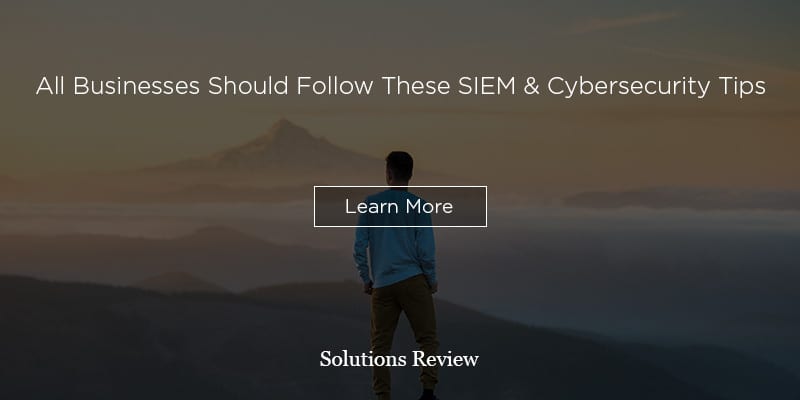All Businesses Should Follow These 4 SIEM & Cybersecurity Tips!


Below, we offer a list of some of the most important SIEM tips we could find. But why should your enterprise take them to heart? How can these SIEM tips clarify and reinforce your cybersecurity policies?
We answer these questions and more below:
Why All Businesses Need These SIEM Tips
Businesses need SIEM to ensure complete cybersecurity. Hackers won’t beat around the bush in their attacks. Thus neither should we. The current studies on enterprise cybersecurity indicate a perilous digital threat landscape:
- 1 in 5 Americans lack basic security knowledge, according to AT&T Cybersecurity.
- 60% of cyber attacks involve lateral movements through enterprise IT environments.
- 90% of digital retail login attempts stem from credential stuffing attacks.
- 48% of consumers stopped using the services of at least one enterprise due to a data breach, according to Frost & Sullivan and CA Technologies.
- 48% of enterprises were involved in a publically disclosed data breach.
- 59% of enterprises report moderate to strong long-term negative impact to business results after a breach.
- 86% of consumers prefer security over convenience.
Additionally, the following SIEM tips apply to all businesses of all sizes. Previously, SIEM carried a reputation of only serving the needs of global enterprises. Given that those early adopters emphasized SIEM as a compliance tool, this made sense.
However, in recent years the cybersecurity paradigm shifted. Where once a prevention-based model held sway, now a detection-and-remediation model takes precedence. Not to put too fine a point on it, but every business needs strong detection and remediation as provided by SIEM to survive. According to Switchfast Technologies, 60% of small-to-medium businesses (SMBs) go out of business within six months of a data breach.
Moreover, SIEM offers distinct capabilities to smaller enterprises. Mid-market enterprises can deploy SIEM to achieve formalized storage, threat prioritization, and investigation capabilities. Meanwhile, small to medium-sized businesses can use SIEM to centralize their cybersecurity visibility into their different IT systems and correlate their log data.
The Top 4 SIEM Tips for Enterprises
Of course, no list could encompass all of the top SIEM tips for enterprises. However, we feel this list highlights some of the most relevant and some of the most neglected cybersecurity best practices. We hope you take them to heart as you map out your SIEM protocols and platforms.
Know Your Success Criteria
One crucial question should contextualize all of these SIEM tips: why do you want to deploy SIEM on your enterprise IT environment?
Of course, you may only want SIEM for its threat detection and remediation capabilities; indeed, this may prove perfectly adequate. Yet thinking about SIEM in this manner may limit its effectiveness and could curtail some of your other goals.
After all, no two SIEM solutions look exactly the same; some handle distinct enterprise use cases better than others, and some offer capabilities others don’t.
You should work with your IT security team to determine your own use case based on your enterprise’s industry, size, and current and projected IT environment. Then you can select a SIEM solution which matches most with your overall business goals and IT environment growth.
Some business use case factors include compliance, authentication tracking, EDR support, log and threat intelligence correlation, and cloud activity monitoring. Additionally, this conversation should help you determine the best place to begin your SIEM deployment and the optimal data collection methods.
Understand the Less Prominent SIEM Capabilities
We detailed some of the most important SIEM capabilities for enterprises in previous articles. However, while many enterprise-level solutions share similar major capabilities, they severely differ in the less prominent SIEM capabilities.
As part of our SIEM tips, we recommend you investigate these unique capabilities to determine your solution’s true compatibility. Some places to start include:
Alternative SIEM Deployment Options
Not every solution deploys the same way. Some solutions offer multiple deployment options, and some only offer one. You should pick a solution which matches with your current and projected IT environment; for example, a plan to undergo digital transformation should prompt a choice of a cloud-based or managed deployment.
A few deployment methods include:
- Cloud-based
- Managed detection and response (MDR)
- SIEM-as-a-Service
- Co-Managed SIEM
- All in One Appliance
Integration
Of all the SIEM tips and less prominent capabilities listed here, integration often proves the most neglected. Yet the integration of SIEM products with particular IT environments and already deployed cybersecurity solutions could determine its success…or its failure.
Integration success could result in more coordinated threat intelligence and more comprehensive threat detection. On the other hand, integration failures could open dangerous security gaps and vulnerabilities.
Your potential next-gen SIEM solution should provide a list of cybersecurity integrations to help you evaluate its integration capabilities.
Machine Learning
The more you can effectively automate your cybersecurity, the less time and resources your IT security team must invest in investigations. Machine learning, an AI-based capability, can contribute to better contextualization, correlation, and investigation through automated processes.
However, machine learning does require continual monitoring and reevaluation to ensure the correlation rules fit with the threat intelligence and overall cybersecurity goals. Your SIEM solution should facilitate these correlation rule evaluations and adjustments.
Visibility and Dwell Time Reduction
No list of SIEM tips would be complete without mentioning the power of visibility in cybersecurity. Dwelling threats can linger on your network for, on average, well over 6 months. Remediation after detecting such a long-standing threat can take another 2 months at least.
SIEM should facilitate your visibility, removing any concealment hackers can use to their advantage. Your network often encompasses areas and devices you didn’t expect, and you cannot protect what you cannot see.
Improve Your Security Operations Center Efficiency
Cybersecurity and SIEM, in particular, must become a full enterprise endeavor; best practices participation from all of your employees, privileged users, and third-parties helps ensure its optimal performance.
However, your security operations center should serve as your enterprise’s vanguard, deploying and assessing your SIEM practices and incorporating new SIEM tips into their evaluations.
Therefore, you should take the time and invest the resources to build a fully functioning security operations center. This involves assembling a team of professionals with clear cut roles within the security operations center; additionally, it requires providing them with the right tools to optimize their response time, false positive investigation time, and threat intelligence.
You can do this by selecting a strong SIEM solution well-suited to your business use case. Moreover, you can do so by incorporating top-quality cybersecurity threat intelligence from multiple sources. This should help your team build better correlation rules and adapt their best practices.
SIEM is a Marathon, Not a Sprint
In the olden days of global commerce, any enterprise venturing onto the high seas had to contend with a certain amount of risk with every voyage. Storms, pirates, or human error could cost a ship of cargo and devastate its owners. Yet the riches a far-flung voyage could bring incentivized those early businesses to take the risks…in a safe manner.
No one could completely mitigate the effects of a lost ship, but they could take the steps to mitigate the risks and the potential fallout as much as possible. Trade security was a marathon, not a sprint—a process, rather than a simple goal.
Nowadays, enterprises face a different kind of piracy, but the security principles remain the same. We’ll never completely contain hackers and their cyber attacks. However, we can adjust our cybersecurity strategies to prepare for the inherent risks of digital transactions.
If you take away any of these SIEM tips, you should take the idea of cybersecurity overall as a marathon, not a sprint, to heart. You need to prepare and adjust and evaluate constantly; there is no option to “set-it-and-forget-it.” Additionally, your enterprise should prepare for a data breach with a strong incident response plan and with backup technologies.
Above all, you should always have a strong next-gen SIEM solution deployed to serve as a lookout for potential threats attacking your enterprise ship. The waves of digital interactions can prove dangerous. You’ll need clear eyes to navigate them safely.
Widget not in any sidebars



















